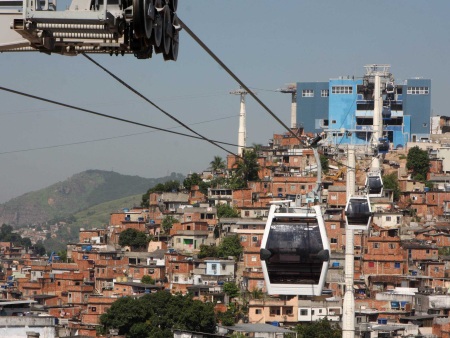Roussef's remarks come after her inaugural ride on the 6-station teleferico last week. The President expressed pride and hopefulness when asked about the recent Accelerated Growth Program (PAC) upgrading that has taken place in the Complexo since it was occupied by the military last fall, stating:
"O PAC está mudando a vida no Complexo do Alemão. Por isso, para mim foi motivo de orgulho fazer a viagem inaugural do teleférico, passando pelas seis estações do Complexo do Alemão. A subida do morro passou a ser feita com conforto, com segurança e em apenas 15 minutos - disse. - O Complexo do Alemão tem tudo para se transformar em um ponto turístico." "The Program for Accelerated Growth is changing lives in the Complexo do Alemao. So, for me, accompanying the teleferico's first voyage filled me with pride, passing through the six stations of the Complexo do Alema. The climb up the hill can now be done with comfort, security, and within 15 minutes. The Complexo do Alemao has all it needs to become a tourist destination."
 |
| One of the 6 teleferico stations in Alemao. All are located on summits of the hills that comprise the Complexo. Photo credit: R7 |
In light of the mega-event-related revitalization of Rio's Port Zone, the municipal government is pitching a similar argument in favor of an identical teleferico in the Morro de Providencia. The installation of the teleferico will force the eviction of up to 300 families, prompting further speculation about who the true beneficiaries of the transport system truly are.
Having spoken to residents of both communities, it seems clear that the telefericos will not be used largely among Providencia and Complexo families. Cost, inappropriate positioning of stations, and "e so para gringo ver (it's just for tourists to see) were all cited by residents as proof that the system has not been catered to their needs. Additionally, it is notable that community residents underscore the importance of educational and job opportunities, healthcare access, and proper sanitation over the installation of the teleferico.
E so para gringo ver, indeed.
Having spoken to residents of both communities, it seems clear that the telefericos will not be used largely among Providencia and Complexo families. Cost, inappropriate positioning of stations, and "e so para gringo ver (it's just for tourists to see) were all cited by residents as proof that the system has not been catered to their needs. Additionally, it is notable that community residents underscore the importance of educational and job opportunities, healthcare access, and proper sanitation over the installation of the teleferico.
E so para gringo ver, indeed.
*in an interview with leading political scientist Maria Helena Moreira Alves, I was informed that Providencia residents will have free access to the teleferico only for the initial two months after the inauguration.

No comments:
Post a Comment